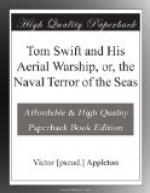“Well, I guess we re ready,” he finally announced. “All aboard!”
“Bless my insurance policy!” exclaimed Mr. Damon. “Now that the time comes I almost wish I wasn’t going.”
“Nonsense!” exclaimed Tom. “You’re not going to back out at the last minute. All aboard! Cast off the ropes!” he cried to the assistants.
A moment later the Mars, the biggest airship Tom Swift had ever constructed, arose from the earth like some great bird, and soared aloft.
“Well, Tom, we’re moving!” cried Ned Newton, clapping his chum on the back, as he stood near him in the pilot-house. “We’re going up, old sport!”
“Of course we are,” replied Tom. “You didn’t think it wouldn’t go up, did you?”
“Well, I wasn’t quite sure,” Ned confessed. “You know you were so worried about—”
“Not about the ship sailing,” interrupted Tom. “It was only the effect the firing of the guns might have. But I think we have that taken care of.”
“Bless my pin cushion!” cried Mr. Damon, as he looked over the rail at the earth below. “We’re moving fast, Tom.”
“Yes, we can make a quicker ascent in this than in most aeroplanes,” Tom said, “for they have to go up in a slanting direction. But we can’t quite equal their lateral speed.”
“Just how fast do you think you can travel when you are in first-class shape?” asked Lieu tenant Marbury, as he noted how the Mars was behaving on this, the first trip.
“Well, I set a limit of seventy-five miles an hour,” the young inventor replied, as he shifted various levers and handles, to change the speed of the mechanism. “But I’m afraid we won’t quite equal that with all our guns on board. But I’m safe in saying sixty, I think.”
“That will more than satisfy the government requirements,” the officer said. “But, of course, your craft will have to come up to expectations and requirements in the matter of armament.”
“I’ll give you every test you want,” declared Tom, with a smile. “And now we’ll see what the Mars can do when put to it.”
Up and up went the big dirigible aerial warship. Had you been fortunate enough to have seen her you would have observed a craft not unlike, in shape, the German Zeppelins. But it differed from those war balloons in several important particulars.
Tom’s craft was about six hundred feet long, and the diameter of the gas bag, amidships, was sixty feet, slightly larger than the largest Zeppelin. Below the bag, which, as I have explained, was made up of a number of gas-tight compartments, hung from wire cables three cabins. The forward one was a sort of pilot-house, containing various instruments for navigating the ship of the air, observation rooms, gauges for calculating firing ranges, and the steering apparatus.
Amidships, suspended below the great bag, were the living and sleeping quarters, where food was cooked and served and where those who operated the craft could spend their leisure time. Extra supplies were also stored there.




